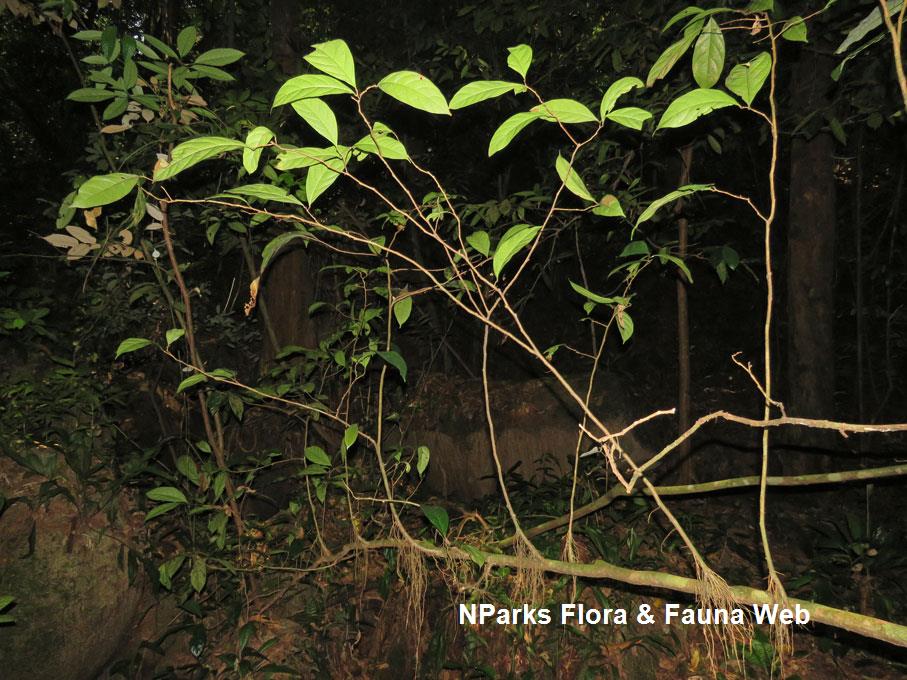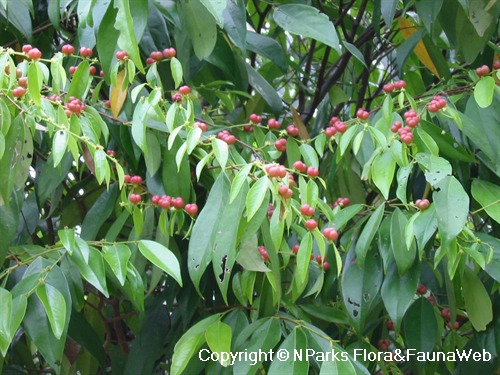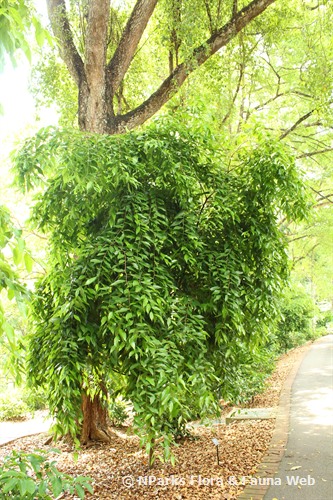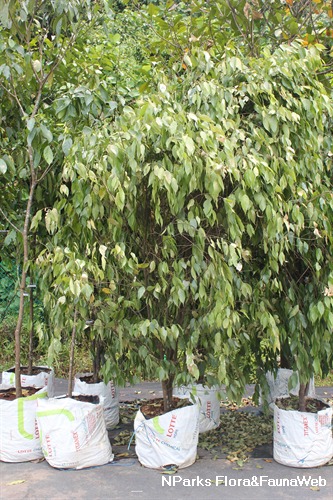.jpg)
Back
Cleistanthus macrophyllus Hook.f.
| Family Name: | Phyllanthaceae |
Cleistanthus macrophyllus is a large shrub to small tree, critically endangered to Singapore. Growing to a height of 6 m tall, it has leathery leaves, small whitish flowers and 3-lobed fruit that splits upon maturity. The male and female flowers are produced separately on the same plant, held on an inflorescence along the axils. They are star-like with 5 petals and 5 sepals, bearing numerous hairy bracts.
Name
Classifications and Characteristics
| Plant Division | Angiosperms (Flowering Seed Plants) (Dicotyledon) |
|---|---|
| Plant Growth Form | Tree (Small (6m-15m)) |
| Maximum Height | 6 m |
Biogeography
| Native Distribution | Southeast Yunnan, Indonesia, Peninsular Malaya, Singapore and Thailand |
|---|---|
| Native Habitat | Terrestrial (Primary Rainforest, Secondary Rainforest) |
| Preferred Climate Zone | Tropical |
| Local Conservation Status | Native to Singapore (Critically Endangered (CR)) |
Description and Ethnobotany
| Growth Form | It is a smooth, small-sized tree to large shrub, growing up to 6 m tall. |
|---|---|
| Foliage | Leaves are leathery, varying between the shapes of spoon-like, oblong to elliptic, measuring 14 - 30 cm long by 8 - 15 cm wide. Held on a short leaf stalk of 0.6 - 0.8 cm long, it is glossy below and veinlets are visible on both sides. |
| Flowers | Flowers are monoecious whereby the female and male flowers are produced separately on the same individual. Flowers are small, whitish, held on an inflorescence at the axils, each producing 5 sepals and 5 petals, supported by numerous hairy, egg-shaped bracts. |
| Fruit | The fruit is a pale brown, 3-lobed capsule which spilt open when matured. It measures between 0.7 - 1.5 cm wide, revealing its smooth seeds of up to 2 per lobe. |
| Habitat | Occurs in evergreen forest, along streams on limestones, up to 700 m in altitude. |
| Cultivation | It can be propagated by seed. |
Plant Care and Propagation
| Light Preference | Full Sun |
|---|---|
| Water Preference | Moderate Water |
| Plant Growth Rate | Moderate |
| Rootzone Tolerance | Fertile Loamy Soils, Well-Drained Soils |
| Propagation Method | Seed |
Foliar
| Foliage Retention | Evergreen |
|---|---|
| Mature Foliage Colour(s) | Green |
| Mature Foliage Texture(s) | Leathery |
| Foliar Type | Simple / Unifoliate |
| Foliar Arrangement Along Stem | Alternate |
| Foliar Attachment to Stem | Petiolate |
| Foliar Shape(s) | Non-Palm Foliage (Elliptical, Obovate, Oblong) |
| Foliar Venation | Pinnate / Net |
| Foliar Margin | Entire |
| Foliar Apex - Tip | Mucronate |
| Foliar Base | Acute, Rounded / Obtuse |
Non - Foliar and Storage
| Stem Type & Modification | Woody |
|---|
Floral (Angiosperm)
| Flower & Plant Sexuality | Unisexual Flowers , Monoecious |
| Flower Colour(s) | Cream / Off-White, Green |
|---|
| Flower Grouping | Cluster / Inflorescence |
| Flower Location | Axillary |
| Flower Symmetry | Radial |
| Individual Flower Shape | Stellate / Star-shaped |
| Inflorescence Type | Cyme |
| Flowering Habit | Polycarpic |
Fruit, Seed and Spore
| Mature Fruit Colour(s) | Brown |
|---|---|
| Fruit Classification | Simple Fruit |
| Fruit Type | Dehiscent Dry Fruit , Capsule |
References
| References | <1> Li, B & Dressler, S. (2008). Cleistanthus. In: Wu, Z. Y., P. H. Raven & Hong, D. Y. (eds.) Cleistanthus. Flora of China, vol. 11, pp. 172-174. Beijing: Science Press and St. Louis: Missouri Botanical Garden Press. <2> Roisungnern, K. & Chayamarit, K. (2005). Flora of Thailand, vol. 8(1): pp. 174. Bangkok: The Forest Herbarium, National Park Wildlife and Plant Conservation Department. |
|---|
Image Repository
Others
| Master ID | 33892 |
|---|---|
| Species ID | 8308 |
| Flora Disclaimer | The information in this website has been compiled from reliable sources, such as reference works on medicinal plants. It is not a substitute for medical advice or treatment and NParks does not purport to provide any medical advice. Readers should always consult his/her physician before using or consuming a plant for medicinal purposes. |

.jpg)
.jpg)



